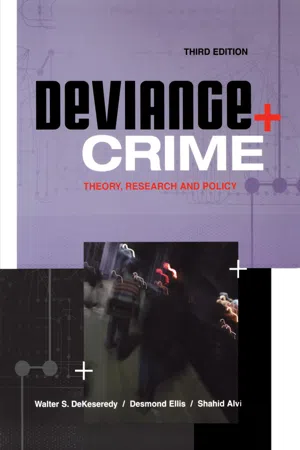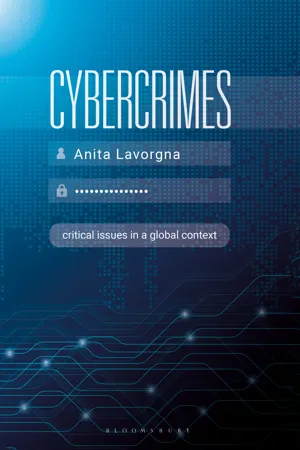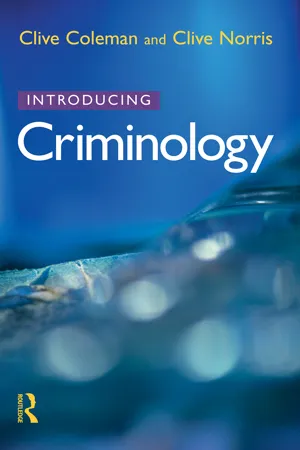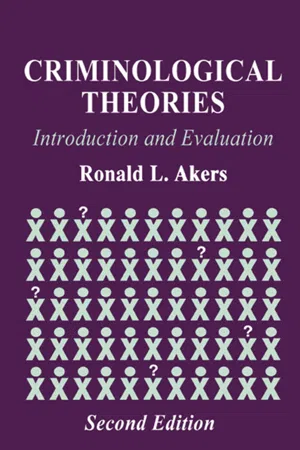Social Sciences
Interactionism Crime
Interactionism in the study of crime focuses on how individuals and society interact to construct definitions of crime and deviance. It emphasizes the importance of social interactions, labeling, and the subjective nature of crime. Interactionist perspectives highlight the role of social processes in shaping criminal behavior and the significance of societal reactions to individuals labeled as criminals.
Written by Perlego with AI-assistance
Related key terms
Related key terms
1 of 4
Related key terms
1 of 3
4 Key excerpts on "Interactionism Crime"
- eBook - ePub
Deviance and Crime
Theory, Research and Policy
- Walter DeKeseredy, Desmond Ellis, Shahid Alvi(Authors)
- 2014(Publication Date)
- Routledge(Publisher)
Third, while the metaphor of multi-player games such as ice hockey, football, or baseball may be applied to symbolic interaction and society, Mead’s game has one very important and distinctive property: in the course of interacting with each other, self-images and the rules of the game may be changed. New self-images and rules may be created, some rules applied, and other’s not. Simply examining the game’s rules as they appear in the rule book will not tell you very much about how the game is actually played or about the course of the game. Games like ice hockey have an emergent quality to them, and the process of emergence must be studied directly. The game’s structure, its rules, and its competitive values should be taken into account, but the primary focus of analysis is the process of symbolic interaction. The large, many-player game called society emerges out of, and can be changed by, the symbolic interaction that takes place among individuals in such small-scale settings as homes, schools, workplaces, churches, and so on.Most sociologists who adopt a social psychological, symbolic interactionist approach to the study of deviant and/or criminal social behavior in these settings work with a set of sensitizing concepts bequeathed them by Mead. These include interaction, symbols, meanings, process, emergence, and self-concept. A few have borrowed concepts formulated by other theorists, and some have tried to combine Mead’s micro-sociological approach with a macro-sociological one.In Chapter 1 , we briefly described one type of interactionist theory that has been applied to the study of crime and deviance: the societal reaction/labeling perspective. There, we said that societal reaction/labeling theorists want to develop a sociological understanding of how people and behaviors come to be designated as criminal or deviant. This is very different from wanting to describe the causes of crime. Recall that for scholars such as Howard Becker (1973), nothing is inherently deviant or criminal. Rather, crime is a social construct or a label attached to a behavior during the course of social interaction between rule-makers and rule-breakers. Here, we introduce you to one major variant of the interactionist perspective: Sutherland’s differential association theory.Differential Association Theory
As originally formulated by Sutherland (1947) and later revised by Sutherland and Cressey (1966), differential association theory is an interactionist account of both conformity and deviation. However, because of its inclusion of motives, its emphasis on the original or random causes of deviance/crime, and its acceptance of the traditional notion that social control is caused by deviance instead of vise versa, differential association theory differs from the interactionist accounts reviewed in Chapter 1 - eBook - ePub
Cybercrimes
Critical Issues in a Global Context
- Anita Lavorgna(Author)
- 2020(Publication Date)
- Bloomsbury Academic(Publisher)
As anticipated above, a key influence from the Chicago School has been symbolic interactionism, which looks at the ways in which meaning arises in social interactions through communication using language and symbols. Contrary to other social structure approaches, according to interactionist theorists, some individuals do not become criminals because of blocked opportunity structures or their socialisation; crime is rather the product of the interactions certain individuals have with others, who label a certain behaviour as ‘crime’. Crime, then, is socially constructed. By starting from these premises, labelling theorists describe a general process whereby it is the external intervention (from law enforcement or significant others) to create crime. As explained by Edwin Lemert (1951), many individuals (especially children) engage in sporadic deviant acts (primary deviance): these acts generally go unnoticed and have little impact on those individuals’ lives. Some deviant acts, however, will be noticed and their authors will be labelled as delinquent; they will start to internalise this new tag, which will define them negatively, affecting their self-image (secondary deviance). The labelled individuals may come to accept their self-concept as ‘delinquent’ and start to engage in criminal behaviour accordingly.Working within the framework structured by Lemert, Howard Becker (the main theorist within labelling theory) illustrated how crime is the product of social interactions. In his seminal book Outsiders, Becker (1963, p. 9) explained how certain social groups ‘create deviance by making the rules whose infraction constitutes deviance, and by applying those rules to particular people and labelling them as outsiders’. Particularly, so-called moral entrepreneurs aim to propagate their viewpoint, creating or enforcing norms in line with their understanding of what is best.An important implication of labelling approaches is that social stigma is key not only to understand crime but also to prevent and mitigate it. Furthermore, the labelling perspective has a clear focus on how power and conflict shape society, emphasising the influence of powerful groups in society to both define and react to deviant behaviour, generally to the detriment of the less powerful. Regarding cybercrimes, this perspective is at the basis of the debates of the (de)criminalisation of certain activities, and it is necessary to understand how cybercrime has been socially constructed – a theme that will be recurrent in the book and that we will encounter in more detail, for instance, when discussing hacking and certain forms of intellectual property infringement. - eBook - ePub
- Clive Coleman, Clive Norris(Authors)
- 2013(Publication Date)
- Willan(Publisher)
et al , 1979, 1985; Hagan 1988), and frequently appears as a component in more broad-ranging theories of crime (see, for example, Braithwaite 1989). Meanwhile, Hirschi himself appears to have drifted away from his more sociologically inclined control theory, now pressing the claims of a general theory of crime that stresses the role of low selfcontrol. This emphasises the importance of a relatively stable individual characteristic, for which the major cause is seen as ineffective child rearing (Gottfredson and Hirschi 1990) – a further example, perhaps, of the revival of approaches focusing on the individual discussed in the last chapter.Interactionism, labelling and moral panics
For much of its history, as we have seen, criminology has concentrated on the question of aetiology: what are the original causes of crime and delinquency? The attempts to answers this question have varied; biological, psychological and sociological approaches in particular have been employed. Although control theory tried to ask the key question in a rather different way, it was still concerned with the causes of conforming and delinquent conduct. A rather different focus emerged from a group of sociologists (e.g. Becker 1963: Lemert 1951, 1967) who were working within the tradition of what is called symbolic interactionism, an approach which focuses upon the symbolic meanings and understandings which are developed in the course of social interaction. Complex social interaction was seen as a rich field for investigation, and deviance, rather than crime, became one of the objects of attention. Such an approach urged the study of social processes such as the definition of deviance, social reactions to it, and the emergence of deviant identity, which it felt had been much neglected in the study of crime and deviance. Perhaps because of some well known passages in the work of Howard Becker (1963), commentators began to speak of the emergence of something called labelling theory, even though the approach was not only concerned with labelling, and, on its own admission, was hardly systematic or grand enough to be called a theory in the strict sense. In addition, labelling could be, and was, analysed with the help of a range of perspectives in sociology, not just interactionism (Plummer 1979). The ‘labelling’ and interactionist perspectives on deviance were not, therefore, identical. - eBook - ePub
Criminological Theories
Introduction and Evaluation
- Ronald L. Akers(Author)
- 2013(Publication Date)
- Routledge(Publisher)
Notwithstanding the value of theoretical integration as an ideal, in practice integrated models in criminology have met with mixed success and acceptance. Some have received empirical support, while others have received little or no testing. Many have been ignored. Within the overall favorable climate of opinion in criminology toward theoretical integration, there continues to be a considerable indifference and a healthy skepticism toward integration as a theory-building strategy.Indeed, in spite of my own long-standing orientation to integration and my search for commonalities among theories, I see some value in the oppositional strategy. I have used the competitive approach in pitting social learning against alternative explanations of criminal and deviant behavior (Akers and Cochran, 1985 ; Krohn et al., 1984 ; Boeringer and Akers, 1993 ). The social learning integration of principles of differential association and reinforcement has been successful, empirically sustained, and has received considerable attention in criminology.6 Nonetheless, I still have reservations about the future of theoretical integration (Akers, 1989 ). The issue of theory competition versus theory integration has not yet been, and perhaps should not necessarily be, fully resolved.Summary
Theoretical development takes place through explicating, testing, and modifying a single theory, through competition of rival theories, and through theoretical integration. Theoretical integration can be conceptual and/or propositional. It entails either theories at the same level of explanation or theories from different explanatory levels. Social learning theory, in one way or another, is a main component of integrative models in criminology, along with social bonding and strain theories.Pearson and Weiner present a framework for integrating concepts from all
Index pages curate the most relevant extracts from our library of academic textbooks. They’ve been created using an in-house natural language model (NLM), each adding context and meaning to key research topics.
Explore more topic indexes
Explore more topic indexes
1 of 6
Explore more topic indexes
1 of 4



